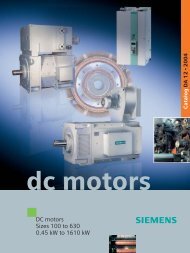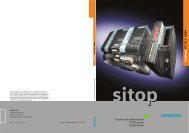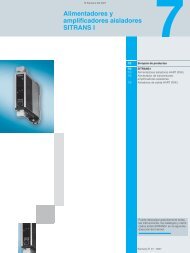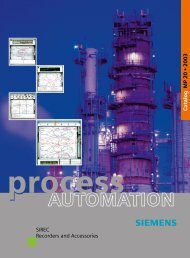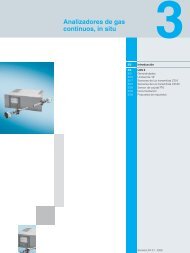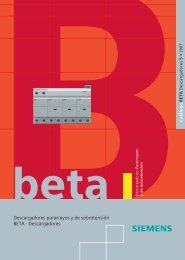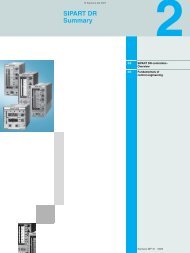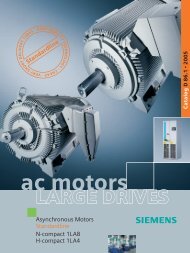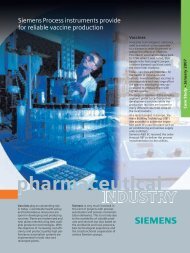Create successful ePaper yourself
Turn your PDF publications into a flip-book with our unique Google optimized e-Paper software.
3<br />
Measuring systems<br />
SIMODRIVE sensor<br />
Built-on optoelectronic rotary encoders<br />
Built-on optoelectronic rotary encoders<br />
Application range, design<br />
SIMODRIVE sensors are optoelectrical built-on rotary encoders<br />
for measuring displacement, angles of rotation or speeds on<br />
machines. They can be used in conjunction with numerical<br />
controls, programmable logic controllers, drives and position<br />
displays, such as<br />
7 SIMOTION; motion control systems<br />
7 SINUMERIK; CNC controls<br />
7 SIMATIC; programmable controllers<br />
7 SIMODRIVE and SIMOVERT MASTERDRIVES MC;<br />
drive systems<br />
A basic differentiation is made between incremental and absolute<br />
measurement techniques. Because the position of the control<br />
is not normally stored and movements of the machine are not<br />
recorded during an emergency off, the use of incremental<br />
encoders requires that the machine carries out a reference-point<br />
approach after every emergency off.<br />
As opposed to this, absolute value encoders also record these<br />
movements and supply the current position after emergency off.<br />
There is no need for a reference-point approach.<br />
All encoders can be supplied in the synchro-flange and clamp<br />
flange versions. Encoders with synchro-flange can be attached<br />
with 3 clamps to the machine. A mounting with axial screws is<br />
also possible. The encoder is driven by a push-on coupling or<br />
spring disk coupling. Belt pulleys are also a possible alternative.<br />
The power supply for the encoder is 5 V DC or optionally 10 V to<br />
30 V DC. The 10 V to 30 V version permits longer cable lengths.<br />
Most control systems provide the supply voltage directly from<br />
the measuring circuit.<br />
1) For references on the subject PROFIBUS, see Section 12 »Documentation«<br />
in Catalog NC 60 · 2002.<br />
3/2<br />
Siemens NC Z · 2002/2003<br />
Measuring systems<br />
Mode of operation<br />
Incremental encoder<br />
These encoders supply a defined number of electrical pulses for<br />
each revolution that is the measurement of the traveled path or<br />
angle.<br />
Incremental encoders operate by scanning code disks photoelectrically<br />
using the backlighting method. A light-emitting diode<br />
(LED) is used as the source. Photoelectric elements record the<br />
light-dark modulation caused by the turning encoder shaft. The<br />
suitable arrangement of the bar pattern on the coded disk<br />
attached to the shaft and the fixed aperture permit the<br />
photoelectric elements to supply A and B track signals that are<br />
displaced at 90° to each other and also a reference signal R. The<br />
encoder electronics amplifies these signals and converts them<br />
into various output levels.<br />
The following output levels are available:<br />
7 RS 422 difference signals (TTL)<br />
7 Sine/cosine analog signals with level 1 Vpp 7 HTL (High Voltage Transistor Logic)<br />
The edge evaluation can increase the resolution unit for RS 422<br />
encoders (TTL).<br />
To achieve an even finer resolution, the supervisory control<br />
interpolates the signals from encoders with sinusoidal signals.<br />
Encoders with HTL interface are well suited for use in applications<br />
with digital inputs with 24-V-level.<br />
Mode of operation for absolute value encoders<br />
(Singleturn / Multiturn)<br />
Although absolute shaft encoders (angular encoders) have the<br />
same design as incremental encoders with regard to the<br />
sampling principle, they possess a larger number of tracks. For<br />
example, Singleturn encoders code 2 13 = 8192 steps for 13<br />
tracks. A single step code (Gray Code) is used. This avoids the<br />
occurrence of sampling errors.<br />
After the machine has been switched on, the position value is<br />
transferred immediately to the control. A reference-point<br />
approach is not necessary. The data transmission between<br />
encoder and control is performed via the synchronous serial<br />
interface (SSI) or via PROFIBUS DP. 1)<br />
SSI and EnDat have advantages for time-critical applications.<br />
Because of the reduced cabling effort required by<br />
PROFIBUS DP, it is more suitable for installations with a large<br />
number of encoders.<br />
The encoders for PROFIBUS DP can be parameterized.<br />
Singleturn encoders convert a revolution (360° mechanical) into<br />
a specific number of steps, e.g. 8192. A unique code word is<br />
assigned to every position. The position values repeat<br />
themselves after 360°.<br />
In addition to the absolute position within a revolution,<br />
Multiturn encoders also record the number of revolutions.<br />
Here samples are taken of the additional code disks coupled<br />
with the encoder shaft using gearboxes. The evaluation of a<br />
further 12 tracks permits 212 = 4096 revolutions to be coded.





